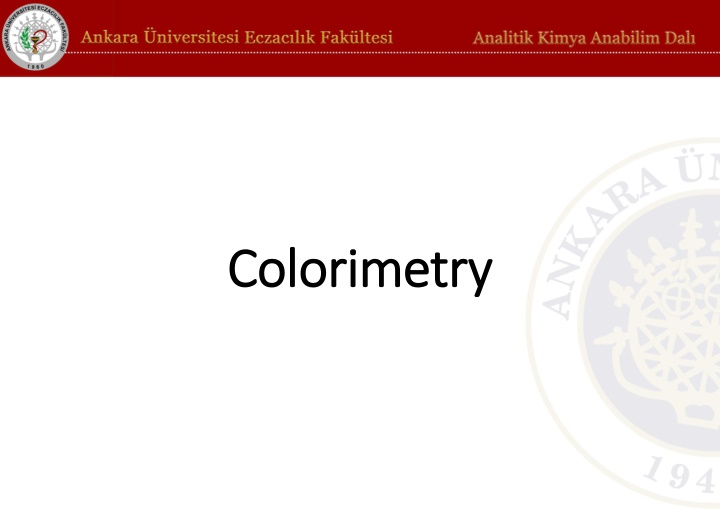
Colorimetry in Daily Life
Explore the significance of colorimetry and how it is used in daily life to analyze substances, determine freshness of food, and conduct quantitative and qualitative material analysis. Discover the relationship between light absorption and color, and learn about colorimetric analyses conducted in laboratories and industries using specialized instruments and software.
Uploaded on | 2 Views
Download Presentation

Please find below an Image/Link to download the presentation.
The content on the website is provided AS IS for your information and personal use only. It may not be sold, licensed, or shared on other websites without obtaining consent from the author. If you encounter any issues during the download, it is possible that the publisher has removed the file from their server.
You are allowed to download the files provided on this website for personal or commercial use, subject to the condition that they are used lawfully. All files are the property of their respective owners.
The content on the website is provided AS IS for your information and personal use only. It may not be sold, licensed, or shared on other websites without obtaining consent from the author.
E N D
Presentation Transcript
Colorimetry Colorimetry
The light having wavelength between 400-800 nm is called visible light because human eyes can perceive this light. The perception is called as color. The color of the light depends on wavelengths of the incoming light. White light contains the whole visible region. Objects can absorb some wavelengths of the white light and remaining lights constitutes the color of the objects. For example, an object that absorbs light around 420-440 nm appears yellow. Objects which do not absorb light in the visible region appear white while objects which absorb the whole visible region appear black.
There are three things that can happen when a light come through an object: it can be absorbed (subsequently the object can fluoresce) or it can be scattered by the object or it can pass through the object without any interaction. The light that are not absorbed by the substances (emissions are also included in case of fluorescence) constitutes the color of the substances. Therefore, there is a relationship between light absorption and the color. In the following table this relationship is tabulated. One can guess the region of light absorption of a substance by looking the color of it.
We make some daily-life analyses using the color of substances. For example, the color can give an idea about whether a food is fresh or even delicious or not. The color of a tea tells us how much strong it is and how much aromatic compounds it contains. It is possible to conduct quantitative analysis by using color intensity as well as qualitative analysis of materials by looking at the color. Because the color intensity is proportional to the concentration of the substances. The analysis in which the concentration of compounds is determined by the color of them is called colorimetry. In laboratories, colorimetric analyses are generally conducted indirectly using spectrophotometers. However, in some areas where precise color measurements are very important such as clothing industry, special colorimetry instruments are used. Moreover, there are softwares that can measure the color intensity from photographs and using these softwares, colorimetric analysis can also be conducted by using computers or even mobile phones.
Fe3+ 3+ Analysis Analysis Colorimetric Colorimetric Fe You will receive 5 different tubes which contain different concentrations of Fe as 0.5 ppm, 2 ppm, 4 ppm, 8 ppm, 11 ppm and 14 ppm as a bench. Add 1 mL of 3 mM K4(Fe(CN)6).3H2O to each sample using graduated pipette and mix it. Put your phone having the programme and place your phone on a fixed place. For analyzing your sample, place your sample at the same point on a white piece of paper for each sample. Calculate your regression equation using your calculator. Find the concentration of your unknown sample by using the regression equation.


